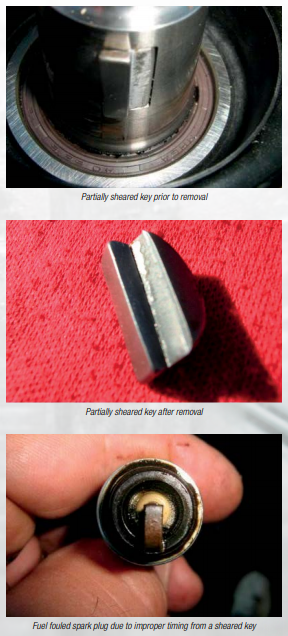The flywheel key, also commonly called the
Woodruff key, is used as a positioning device on the
crankshaft to locate the flywheel (rotor) correctly.
If the flywheel is not correctly positioned, various
sensors (such as the crankshaft position sensor and
pulse coil sensor) that take timing information from
the flywheel will get incorrect information.
The flywheel key positions the flywheel, but it is
not designed to restrict flywheel movement on
the crankshaft. Such movement will shear the
key. Properly tightening the flywheel to the correct
torque, with the tapered area clean and dry,
ensures a tight fit to the taper on the flywheel and
crankshaft, binding the two into place.
If the flywheel is not torqued properly, several things
can happen in addition to the common problem of
a sheared flywheel key.


If it’s not tightened enough, the flywheel can come loose. But if the flywheel is tightened too tightly, such as with an air-impact gun,
the flywheel taper can be stretched, causing it to
become deformed and lose tension, also resulting in a
loosened flywheel.
Whatever the cause of flywheel loosening, extensive
and expensive damage will be caused. Depending
on the model, the flywheel could contact the stator,
pulser coil, crank position sensor, internal covers, and
wiring harness. Also, as the flywheel chatters, extreme
heat from friction could develop and fuse (weld) the
flywheel to the crankshaft.
Torque specifications exist for a reason. We need to
be sure to use the proper torque specified in each
engine’s service manual for all components, or we
may find ourselves with a situation like the ones
shown here.
